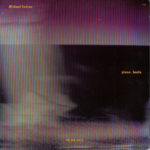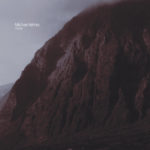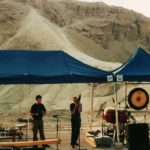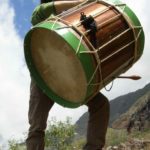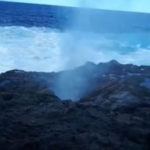„De todo el paisaje herreño
lo que mas atención llama
es el balcón de Jinama.
Lajla Nizinski: Michael, auch dich habe ich auf dem Sonntagsmarkt in La Frontera kennengelernt. Du hast Germanistik, Musikwissenschaft, Theaterwissenschaft und Philosophie studiert. Und du bist Komponist. Du lebst in Utrecht, wo du zwei Jahre im Institut für Sonologie studiert hast. Anschließend warst du der Leiter des „CEM“ Studios in Amsterdam. Mit was beschäftigt sich die Sonologie?
Michael Fahres: Die Sonologie ist eine Wissenschaft, die die Welt der Klänge untersucht.
Du hast viele Projekte durchgeführt. Ich schlage vor, wir nehmen uns die für dieses Interview ausgewählten Projekte chronologisch vor. Bereits 1982 wurde dein Album „Piano. Harfe“ von ECM aufgenommen. Wie bist du in den heiligen Gral von Manfred Eicher gelangt und wie war die Zusammenarbeit mit ihm?
1979 habe ich das „European Minimal Music Project“ gegründet. Wir wollten untersuchen, ob es auch europäische, nicht nur amerikanische minimal Musik gibt. Es war Jürgen Drews, der damalige Leiter des Musikreferats des Goethe-Instituts, der die Verbindung zu ECM herstellte. 1980 entstanden dann meine beiden Stücke „Piano“ und „Harfe“. „Piano“ wurde dann etwa ein halbes Jahr später vom Rundfunk gesendet. Daraufhin rief mich Eicher aus dem Auto auf seiner Reise in die Schweiz an und bot mir einen Plattenvertrag an.
Wir haben über die beiden Stücke lange diskutiert. Er wollte als zweites Stück meine damals neue Komposition „Glasharfe“ nicht so gerne aufnehmen. Wir haben uns dann auf „Harfe“ geeinigt. Ich fuhr 1982 nach Ludwigsburg und habe da die Aufnahme meiner beiden Stücke realisiert. Eicher hatte damals auch Steve Reich unter Vertrag. Die Minimal Musikszene wurde also interessant. 1985 erschien dann die LP.
1994 hast du ein 16stündiges iKonzert am Masadafels in Israel aufgeführt. Der Ring von Richard Wagner dauert ebenso lang. „Sunwheel“ hat die Sonne zum Thema. Wie hast du das gemacht?
Zunächst wurde das Konzert 1992 in Lelystad / Holland in dem Sonnenobservatorium von Robert Morris uraufgeführt. Die Proben fanden übrigens im ATA TAK Studio in Düsseldorf statt. „Sunwheel“ ist eine Landschafts-Umgebungs-Musik, eine Sonnenuhr, die die Geschichte des Lichts erzählt. Zunächst habe ich die Sonne untersucht. Ich wollte die Sonne zum Klingen bringen. Wie ich das gemacht habe, steht hier. 1992 und 1994 haben wir ebenfalls mit den Knistergeräuschen von Feuer gearbeitet.
Auch in Masada zeigten wir am Ende den Film Lektionen der Finsternis von Werner Herzog. Er handelt von den Ölfeldern in Kuwait und zeigt, wie amerikanische Truppen die Ölfelder in Brand steckten. In Masada verwendeten wir auch einen Sonnensynthesizer, der Klänge produzierte, wenn die Sonne darauf scheint. Wir waren die ersten deutschen Musiker, die in Israel in Masada auftraten. Es war ein Gemeinschaftsprojekt mit israelischen Musikern. Schirmherr war das Goethe-Institut in Tel Aviv.
Wir sind hier in El Hierro. Nicht weit von deinem Haus fällt eine steile Felswand hinab in die Golfebene. Friedrich Nietzsche schrieb in „Jenseits von Gut und Böse“: „Und wenn du lange genug in den Abgrund blickst, blickt der Abgrund auch in dich hinein.“ Ist der Titel deiner LP „Tibataje Abseits Jenseits Davor“ eine Entlehnung von Nietzsche?
Ja, das kann man so sagen. Als Kind empfand ich Berge als sehr bedrohlich. Als ich hierher kam, hatte ich Schwierigkeiten mit der riesigen Wand. Ich hörte damals ununterbrochen Arvo Pärt: „Tabula Rasa.“ Ich glaube seine Musik hat mich vor einer Depression gerettet. Seine Musik half mir, die Gewalt des Berges auch als positive Kraft der Natur zu sehen.
Wie seid Ihr bei diesem Projekt bei den fieldrecordings vorgegangen?
Die Musiker spielten Variationen von Rhythmen auf drei großen Trommeln, die auf Hierro hergestellt werden. Diese Rhythmen werden alle vier Jahre zu Ehren der Maria aufgeführt. Vor den Schlagzeugern wurden drei Mikrofone aufgestellt.
Die Musiker standen etwa 50 Meter vom Berg entfernt und in Abständen von 100 Metern zueinander. Außerdem ist weiter oben am Hang ein weiteres Gerät installiert, das überkuppelnd das gesamte akustische Geschehen aufnimmt. Um eine Synchronisation der jeweiligen Tonbandaufnahmen zu gewährleisten ist ein spezielles Beginnsignal, das Schlagen zweier Holzblöcke, vereinbart. In der Landschaft waren Ziegen, Falken, Geckos. Dies alles zusammen echote gegen die riesige Felswand, die das Echo zurück warf. Das war das Neue, ich fing den Sound auf und vermischte ihn mit den Klängen der Musik.
Deine kompositorische Formel könnte lauten: „Performance plus Natursound plus Naturecho“.
Ja, das stimmt.
Auf unserem Blog geht es viel um Ambient und seinen Erfinder Brian Eno. In seiner Sendung am 26.12. wird Michael Engelbrecht Musik von Jon Hassell spielen. Auf deiner CD The Tubes, die du auch auf Hierro aufgenommen hast, hört man die Wellen gegen den Stein schlagen. Und dann setzt die Trompete von Jon ein.
Ja, das sind keine Wellengeräusche. Der Klang kommt von der Bewegung der Wellen des Meers, die das Wasser in die Vulkan-Röhren drücken, deswegen auch „Tubes“. Rein und raus. Das ist ein sehr entspannendes Geräusch, so als ob wir gleichmäßig ein- und ausatmen. Von den 15 Stunden Tonaufnahmen konnte ich allein etwas eine Stunde verwenden, da die Luftgeräusche die Aufnahme übersteuerten . Das war die Urversion. Später kam dann die Version „Crosscurrents“ mit dem aboriginal Didgeridoo Spieler Mark Atkins in Sydney zu Stande – und dann natürlich „The Tubes“ mit Jon Hassel und Mark Atkins zusammen. Wir nahmen übrigens die Trompete mit dem besonderen Röhrenmikrophon von Daniel Schwartz auf, das Mikrophon, das auch Miles Davis verwendete.
Michael, herzlichen Dank für das spannende Gespräch.
